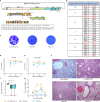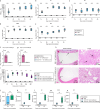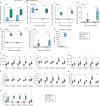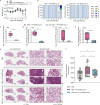A single-dose intranasal live-attenuated codon deoptimized vaccine provides broad protection against SARS-CoV-2 and its variants
- PMID: 39187479
- PMCID: PMC11347628
- DOI: 10.1038/s41467-024-51535-y
A single-dose intranasal live-attenuated codon deoptimized vaccine provides broad protection against SARS-CoV-2 and its variants
Abstract
Severe acute respiratory syndrome coronavirus 2 (SARS-CoV-2, COVID-19) continues its significant health and economic impact globally. Despite the success of spike-protein vaccines in preventing severe disease, long-lasting protection against emerging variants and the prevention of breakthrough infections and transmission remain elusive. We generate an intranasal live-attenuated SARS-CoV-2 vaccine, CDO-7N-1, using codon deoptimization. CDO-7N-1 shows highly attenuated replication and minimal or no lung pathology in vivo over multiple passages. It induces robust mucosal and systemic neutralizing antibody and T-cell subset responses, in mice (female K18-hACE2 and male HFH4-hACE2 mice), hamsters, and macaques triggered by a single immunization. Mice and hamsters vaccinated with CDO-7N-1 are protected from challenge with wild-type (WT) SARS-CoV-2 and other variants of concern. Serum from vaccinated animals neutralizes WT SARS-CoV-2, variants of concern (beta and delta), variants of interest (omicron XBB.1.5) and SARS-CoV-1. Antibody responses are sustained and enhanced by repeated immunization or infection with WT SARS-CoV-2. Immunity against all SARS-CoV-2 proteins by CDO-7N-1 should improve efficacy against future SARS-CoV-2 variants.
© 2024. The Author(s).
Conflict of interest statement
Suresh Mahalingam, Xiang Liu, and Andres Merits are inventors of the live-attenuated SARS-CoV-2 vaccine CDO-7N-1, which has been licensed to Indian Immunologicals Ltd for further development. The study was funded by Indian Immunologicals Ltd. Venugopal Yerragunta, Shukra Madhaha Aavula, Sambaiah Gorriparthi, Santhakumar Ponsekaran, Rama Lakshmi Bonda, Priyanka Mani, Sridevi V. Nimmagadda, Priyabrata Pattnaik, Anand Kumar Kanakasapapathy, and Rajendra Lingala are employees of Indian Immunologicals Ltd. The remaining authors declare no competing interests.
Figures






References
-
- WHO. Weekly epidemiological update on COVID-19 – 1 September 2023, <https://www.who.int/publications/m/item/weekly-epidemiological-update-on... (2023).
MeSH terms
Substances
Supplementary concepts
Grants and funding
LinkOut - more resources
Full Text Sources
Medical
Miscellaneous

